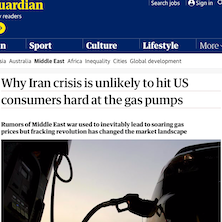 Why Iran crisis is unlikely to hit US consumers hard at the gas pumps
Why Iran crisis is unlikely to hit US consumers hard at the gas pumps
Rumors of Middle East war used to inevitably lead to soaring gas prices but fracking revolution has changed the market landscape
For many older Americans the thought of war in the Middle East will trigger memories of soaring gas prices and long lines at the pumps. But as US relations with Iran sink to a new low there is, as yet, no sign of panic.
US crude oil prices shot higher following the killing of Iran’s top military commander, Qassem Suleimani, by the US last week, but the gains are modest relative to the risk of further escalation of tensions between the US and Iran.
West Texas Intermediate crude-oil prices rose 6% to $64.72 a barrel following news US air forces assassinated Suleimani, commander of the Islamic Revolutionary Guard Corps’ Quds Force.
That 6% rise is tiny compared with the swings seen in years past, largely because of the fracking revolution. Over the last decade fracking has allowed the US to squeeze oil and gas from shale and transformed the country into the largest producer of both.
“If we had the same skirmishing between the US and Iran happening 20 years ago or even 10 years ago, I think the impact on the oil markets would have been a lot bigger, because the shale revolution hadn’t happened yet,” said Stewart Glickman, energy analyst at CFRA Research.
The shale-oil boom made the US largely a self-sufficient energy producer. In October, US producers pumped nearly 12.7m barrels a day of crude oil, a record, according to the latest data from the Energy Information Administration, the statistical arm of the US energy department. In September, the US exported more crude oil and petroleum products than it imported, the first month this has happened since the EIA began monthly record-keeping in 1973.
That’s given the US more geopolitical leverage on oil, said Brian Kessens, managing director and portfolio manager at Tortoise, an energy investment firm. Twenty years ago, the US imported 2.4m barrels of crude oil daily from the Gulf, whereas today it imports only about 700,000 barrels daily, mostly used by east coast refiners, Glickman said, citing EIA October data.
Read more here: https://www.theguardian.com/business/2020/jan/08/iran-crisis-us-consumers-gas-prices-petrol
